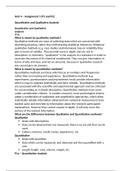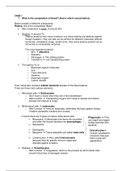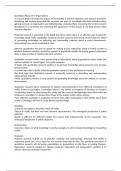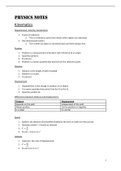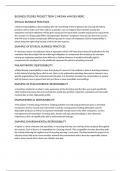Principles of consumer studies
Lecture 2: marketing, goals & learning
Marketing: “creating value for/ satisfying customer companies (that may in
turn create value for/satisfy their customers) with the ultimate goal to create
value for/satisfy the consumer.”
To understand consumers and what they value
- From a groups perspective (household / meso level): consumer
differentiation / market segmentation.
- From an individual perspective (micro level): psychology of consumers
Macro level (e.g., “Dutch consumers”)
Meso level (e.g., “the price conscious)
Micro level (e.g., value orientations)
Learning: “the activity or process of acquiring knowledge or skill by studying,
practicing or experiencing something”
“a relatively permanent change in behaviour, knowledge or thinking skills
that occurs through studying, practicing or experiencing”
à Thus not involved in inborn or innate behaviours (e.g. blinking or
swallowing)
Learning theories
- Behaviourist model (only study observable / external behaviour
- Cognitive model (can scientifically study internal behaviour)
Behavioural learning
Classical conditioning (Pavlov): a learning process in which a previously neutral
stimulus becomes associated with a naturally occurring stimulus, resulting in a
learned response
,Unconditioned stimulus (US): a stimulus that naturally triggers a response
without any prior learning
Conditioned stimulus (CS): previously neutral stimulus that, after being
repeatedly paired with the unconditioned stimulus, starts to trigger a response
First-order conditioning: when a neutral stimulus is directly paired with an
unconditioned stimulus until it becomes a conditioned stimulus, capable of
triggering a conditioned response (dog experiment)
Extinction: if the unconditioned stimulus is removed from the conditioned
stimulus, over time the response will be removed
Higher-order conditioning: a neutral stimulus is paired with an already
established conditioned stimulus instead of an unconditioned stimulus.
Stimulus generalization: when a stimulus similar to a conditioned stimulus
triggers a similar conditioned response
Operant conditioning (Skinner): behaviours are influenced by the
consequences that follow them.
sccl
Reinforcement schedules:
- Continuous reinforcement schedule: a reward is given after every
instance of the desired behaviour
, - Partial reinforcement schedule
o Fixed-ratio schedule: reinforcement is provided after a specific
number of responses have been made
o Variable-ratio schedule: reinforcement is provided after an
unpredictable number of responses
- Interval schedules
o Fixed-interval schedules: reinforcement is provided after a fixed
amount of time has passed, as long as the desired behaviour occurs
o Variable-interval schedule: reinforcement is provided at
unpredictable time intervals
Neutral operants: behaviours/responses that have no effect on the
environment, they do not result in reinforcement or punishment.
Cognitive learning
Information processing model:
Exposure: sensory detection and registration through receptor organs
Attention: requires the focusing of attention, leading to perception and
categorization of stimuli
Comprehension: where the consumer searches (and identifies) meaning
Acceptance/rejection: the consumer considers existing choice criteria and
elaborates the message received to reach a point of acceptance/rejection of the
information
Retention: learning has to be retained in the memory for future use
More successful if stimuli is related to past-experiences/beliefs of consumer
Novel stimuli can gain attention but might not get further in the stages
Memory
Memory: “a system and a process whereby information is received, sorted,
organized, stored and retrieved over time”
Three critical steps to information being remembered:
1. Encoding: how information enters the memory. Comprehending messages
unambiguously for consumers to be able to make sense of, and store, this
information
2. Storage: how the encoded information is retained in the memory
, o
Sensory memory: information in sensory form (e.g. smell), only for
few seconds
o Short-term memory: limited for short time and small amount.
To help marketers getting their messages to be retained is
through chunking: grouping together of similar or
meaningful pieces of information
o long-term memory: can be remembered forever, by encoding
them through engrams: neural networks connecting new memories
with old
3. Retrieval: process whereby we remember and access our stored
memories. Different ways:
o Recollection: reconstruct memory through a range of different
narratives and bits of memory
o Recognition: experiencing it again
o Relearning: relearn something that you had previously learned,
this process helps with remembering and retrieval
Goals: ”desired end-states”
“internal representations of desired states (outcomes, events, processes)
Mastering new skill/knowledge: the intrinsic desire to understand, learn and
master a skill or subject
Performance goal: primary concern about the outcome
Dimensions of goals
- Degree of abstraction of goals: concrete/abstract
- Promotion vs prevention focus: achieving something positive or
avoiding something negative
- Learning vs performance goals
Theories:
Goal setting:
- Expectancy-value theory: you set a goal based on:
Feasibility ( expectancy): how easy of difficult it is to reach the goal
Desirability (value): how much you want to reach the goal
Lecture 2: marketing, goals & learning
Marketing: “creating value for/ satisfying customer companies (that may in
turn create value for/satisfy their customers) with the ultimate goal to create
value for/satisfy the consumer.”
To understand consumers and what they value
- From a groups perspective (household / meso level): consumer
differentiation / market segmentation.
- From an individual perspective (micro level): psychology of consumers
Macro level (e.g., “Dutch consumers”)
Meso level (e.g., “the price conscious)
Micro level (e.g., value orientations)
Learning: “the activity or process of acquiring knowledge or skill by studying,
practicing or experiencing something”
“a relatively permanent change in behaviour, knowledge or thinking skills
that occurs through studying, practicing or experiencing”
à Thus not involved in inborn or innate behaviours (e.g. blinking or
swallowing)
Learning theories
- Behaviourist model (only study observable / external behaviour
- Cognitive model (can scientifically study internal behaviour)
Behavioural learning
Classical conditioning (Pavlov): a learning process in which a previously neutral
stimulus becomes associated with a naturally occurring stimulus, resulting in a
learned response
,Unconditioned stimulus (US): a stimulus that naturally triggers a response
without any prior learning
Conditioned stimulus (CS): previously neutral stimulus that, after being
repeatedly paired with the unconditioned stimulus, starts to trigger a response
First-order conditioning: when a neutral stimulus is directly paired with an
unconditioned stimulus until it becomes a conditioned stimulus, capable of
triggering a conditioned response (dog experiment)
Extinction: if the unconditioned stimulus is removed from the conditioned
stimulus, over time the response will be removed
Higher-order conditioning: a neutral stimulus is paired with an already
established conditioned stimulus instead of an unconditioned stimulus.
Stimulus generalization: when a stimulus similar to a conditioned stimulus
triggers a similar conditioned response
Operant conditioning (Skinner): behaviours are influenced by the
consequences that follow them.
sccl
Reinforcement schedules:
- Continuous reinforcement schedule: a reward is given after every
instance of the desired behaviour
, - Partial reinforcement schedule
o Fixed-ratio schedule: reinforcement is provided after a specific
number of responses have been made
o Variable-ratio schedule: reinforcement is provided after an
unpredictable number of responses
- Interval schedules
o Fixed-interval schedules: reinforcement is provided after a fixed
amount of time has passed, as long as the desired behaviour occurs
o Variable-interval schedule: reinforcement is provided at
unpredictable time intervals
Neutral operants: behaviours/responses that have no effect on the
environment, they do not result in reinforcement or punishment.
Cognitive learning
Information processing model:
Exposure: sensory detection and registration through receptor organs
Attention: requires the focusing of attention, leading to perception and
categorization of stimuli
Comprehension: where the consumer searches (and identifies) meaning
Acceptance/rejection: the consumer considers existing choice criteria and
elaborates the message received to reach a point of acceptance/rejection of the
information
Retention: learning has to be retained in the memory for future use
More successful if stimuli is related to past-experiences/beliefs of consumer
Novel stimuli can gain attention but might not get further in the stages
Memory
Memory: “a system and a process whereby information is received, sorted,
organized, stored and retrieved over time”
Three critical steps to information being remembered:
1. Encoding: how information enters the memory. Comprehending messages
unambiguously for consumers to be able to make sense of, and store, this
information
2. Storage: how the encoded information is retained in the memory
, o
Sensory memory: information in sensory form (e.g. smell), only for
few seconds
o Short-term memory: limited for short time and small amount.
To help marketers getting their messages to be retained is
through chunking: grouping together of similar or
meaningful pieces of information
o long-term memory: can be remembered forever, by encoding
them through engrams: neural networks connecting new memories
with old
3. Retrieval: process whereby we remember and access our stored
memories. Different ways:
o Recollection: reconstruct memory through a range of different
narratives and bits of memory
o Recognition: experiencing it again
o Relearning: relearn something that you had previously learned,
this process helps with remembering and retrieval
Goals: ”desired end-states”
“internal representations of desired states (outcomes, events, processes)
Mastering new skill/knowledge: the intrinsic desire to understand, learn and
master a skill or subject
Performance goal: primary concern about the outcome
Dimensions of goals
- Degree of abstraction of goals: concrete/abstract
- Promotion vs prevention focus: achieving something positive or
avoiding something negative
- Learning vs performance goals
Theories:
Goal setting:
- Expectancy-value theory: you set a goal based on:
Feasibility ( expectancy): how easy of difficult it is to reach the goal
Desirability (value): how much you want to reach the goal

